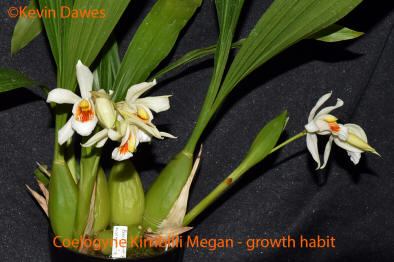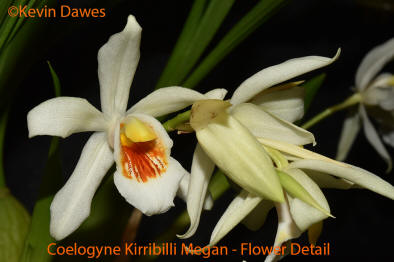
The 'Queen' of Coelogynes, the beautiful white Coelogyne mooreana, has been used as the pod parent (mother) for this 2016 primary hybrid. In this case the variety 'Brockhurst' was chosen because its flower is larger and it has more golden/yellow colouring on its flower lip.
For the pollen parent (father) I chose Coelogyne marmorata. I have been very impressed with the two varieties of this species - a smaller darker form and a larger, more upright form with generally lighter colouring and a large, broad, white lip on an upright flower. Both have delicate marbling patterns on the inner lobes of the flower lip. The larger variety has been used in this new hybrid.
This same variety had an impressive influence when used in creating Coelogyne Kirribilli Ray and Coelogyne Kirribilli Francis. However, in this hybrid its genes have been strongly dominated by the pod parent, Coelogyne mooreana.
In earlier hybrids, Coelogyne mooreana has been consistently dominant. Because it is such a beautiful species itself, all of its offspring are also beautiful. It is a very reliable and predictable breeding parent. The downside is that many hybrids using Coelogyne moorena, even with a wide variety of partners, could result in a certain sameness (economists might refer to the 'law of diminishing returns')! More subtle traits such as the length of flowering period, hardiness and adaptability, etc. may become key issues as the Coelogyne moorena based hybrids experience the test of time.
The primary hybrid (Coelogyne mooreana x Coelogyne marmorata) is powerfully dominated by Coelogyne mooreana. The marbling patterns on the inner lobes of the pollen flower are greatly suppressed and the colour of the veining, throat and central lip have changed from Coelogyne marmorata's chocolate brown to Coelogyne mooreana's vivid yellow/gold. The broad white sepals of Coelogyne mooreana have replaced the thin sepals of Coelogyne marmorata.
Coelogyne marmorata has had two wins in this hybrid, however. It has carried through a very broad white lip and a large broad column with a gold edging. The column is a dominant trait in the new hybrid with the bright colouring expanding to a prominent bright gold feature. The result is a large white flower, enhanced further by a large and wide lip with brilliant yellow/ gold highlights. It has, however, passed on the tall leaves and these tower over the shorter flower spikes. Both parents have passed on common traits such as the synanthous growth pattern (flower spikes emerging from the centre of a new developing psuedobulbs) and simultaneously opening multiple flower spikes.
This plant was bred in Canberra, Australia. It was pollinated on 5th January 2010, flasked on 2nd November 2011, deflasked 15th September 2012 and produced its first flower on 18th September 2016. It was registered as Coelogyne Kirribilli Megan with the Royal Horticultural Society, London, October 2016.
Coelogyne Kirribilli Megan has been named in honour of my wife who has always been a tower of strength throughout my orchid growing adventures.
Negatives: .Despite its white prettiness, it is similar to a number of other Coelogyne mooreana based hybrids. The flower spikes are much shorter than the tall leaves and also tend to weep but are still nicely visible. Both parents are from tropical zones and these hybrids will need a mild climate..
Rating: ♦♦♦♦♦ The large size (7 to 8 cm across) of the pristine white flower and the spectacular contrast of yellow/gold on the lip and column raise this hybrid to be included in the very best of the Coelogyne mooreana based orchids. Additionally, it has a strong perfume. A well-known Australian orchid judge declared that it is "...the prettiest Coelogyne I've ever seen".
Registration: Registration with the RHS as Coelogyne Kirribilli Megan was recorded in October 2016.
Varieties: None known.
Hybrids: None.
| < Coel Kirribilli Marie | Coel Kirribilli Nigel > |

